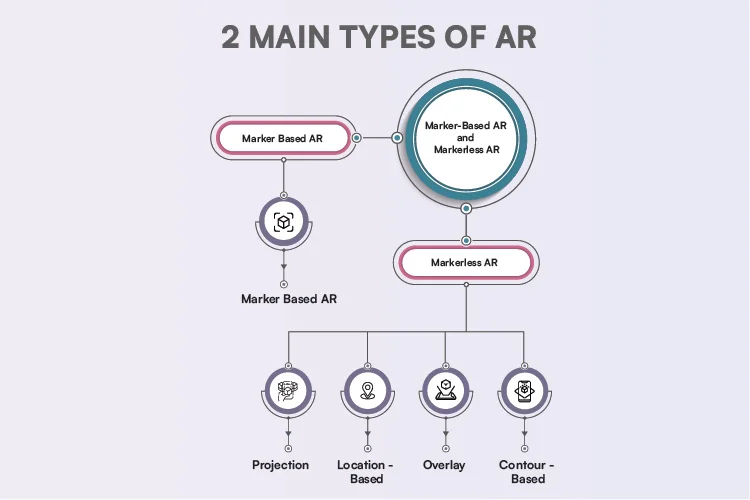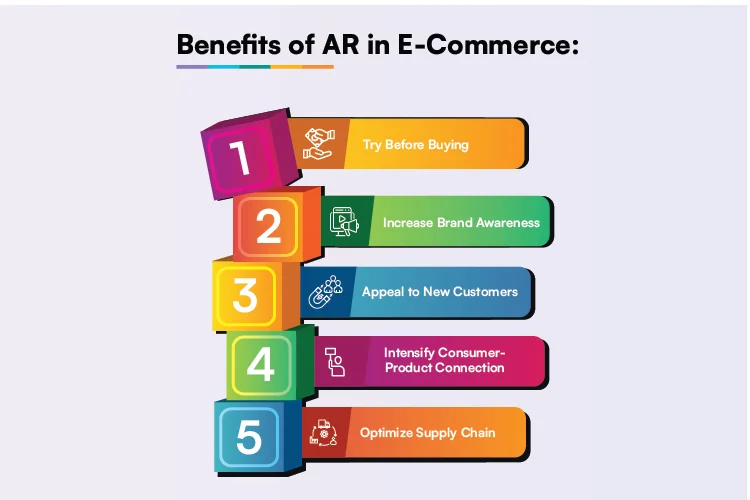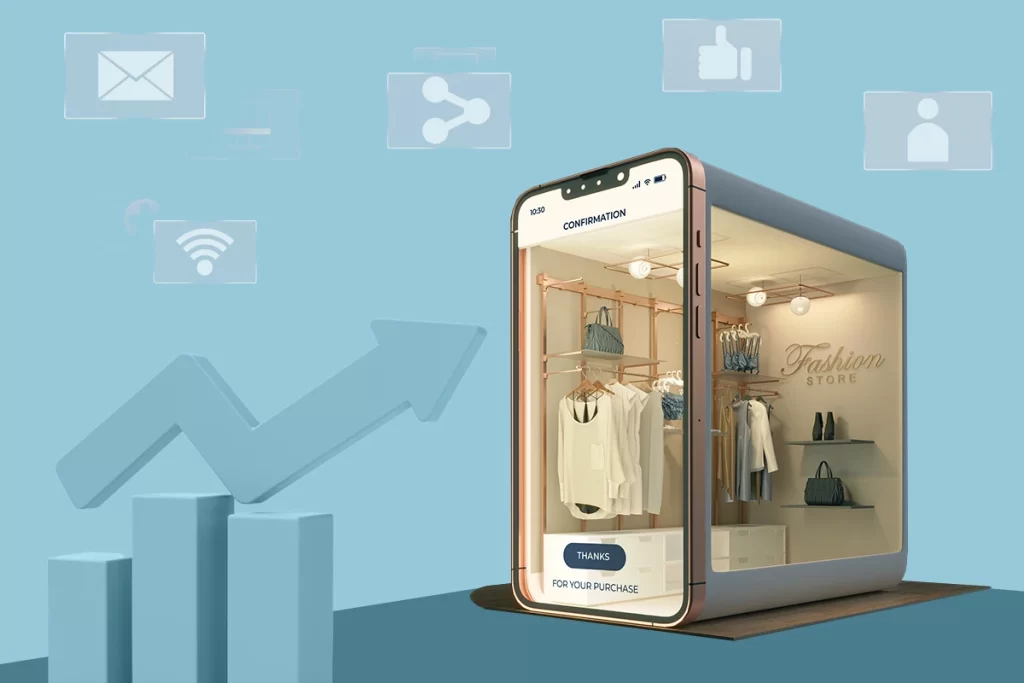When it comes to bridging the gap between in-store and online buying, augmented reality (AR) has emerged as an appealing alternative. With the help of AR, online shoppers can experience things as if they were in a physical store. As a result, augmented reality has ushered in a brand-new age for the e-commerce sector.
From clothing and furniture to toys and shoes to electronics, this technology has altered the shopping habits of consumers across several industries, with the help of AR in e-commerce. Customers can now get a realistic idea of how a product will look in their own homes thanks to augmented reality. A more engaging and customized purchasing experience is now available to them, thanks to technological advancements.
Today many e-commerce platforms, including IKEA, ZeeKit, Nike, etc., are capitalizing on AR to provide their customers with an enhanced online buying experience.
Defining AR:
AR (Augmented Reality) refers to any technique or process that enables the visualization of real-world objects augmented with computer-generated 3D models. This paves the way for virtual and physical items to interact in ways that convey meaning.
Using computer-generated imagery and digital data, AR enhances a view of the real world. The inclusion of moving pictures, infographics, images, and sounds, among other elements, is an attempt to alter opinions.
Virtual 3D graphics are created within the device and then superimposed over real-world items based on their structural relationship, creating AR content. The gadget needs to be able to determine where things are in space and how they’re oriented in relation to one another. Composite pictures are displayed on mobile devices, augmented reality glasses, etc.
According to research, AR is being used increasingly in the retail sector. At a CAGR of 20% between 2022 and 2028, the market is projected to reach about $6.74 billion (about $21 per person in the US).
To avoid falling behind the competition, it’s essential that your company adapt to the changing technological landscape. You’ll need to keep reading this entire blog until you find out how to do that. We provide AR in ecommerce solutions for online retailers, which can help you gain valuable insights for expanding your business.
Let’s move on to building Augmented Reality (AR), there are three major steps involved in building an AR experience.
Developing an AR experience entails three basic steps:
1. The first stage is to employ AR software to generate the 3D experience, or you can use an image as a marker or a platform on which to impose the digital material.
2. The second stage of the process of overlaying the produced images, movies, and 3D objects on images of the real-world environment is the following phase. AR apps typically include thousands of digital assets such as 3D photos and animations. You can also design your own unique elements.
3. The final stage is to share and publish the experience. There are normally three methods for sharing your experience, such as QR codes, URLs, and embedded links.
As a result, an AR in ecommerce experience gives people some influence over it. You may swivel it to view objects from different perspectives, zoom in and out, and do a variety of other things with touch, voice, and other gestures.
Types of AR That Can Be Implemented in your E-commerce:

1. Marker-based AR: It is a type that overlays 3D digital content in the actual world using a camera and a black and white object pattern as a visual identifier. As a result, the AR recognizes the marker using computer vision techniques. This form of augmented application with camera access must scan continually to focus on the input and allow the marker to recognize the image pattern for building the image’s geometry structure.
2. Markerless AR: This type of AR uses computer vision and machine learning algorithms to recognize and track the items, shapes, textures, and even movements in the real world that are in the camera’s view. But “Simultaneous Localization & Mapping” markerless analysis. This looks at the environment and puts the right maps in place so that 3D virtual things can be seen. It can even figure out what things are and what they are like without knowing anything about them.
a. Location-based AR: It uses the user’s GPS, camera, and other sensors to figure out where they are in the real world. It then uses that information to add digital material to the real world around them. It once asked to take a picture of the area, including landmarks, roads, and other things, so that augmented reality apps could perfectly align digital material with the real world.
b. Projection-based AR: This is about the device that shines artificial light on a flat surface to show 3D image details. Using the SLAM model, it can even understand how people interact with the projected enhancement. Using this type of AR, you can even make holograms to give your customers in-store a fun and story-driven experience.
c. Overlay AR: It refers to an application that overlays digital content on the smartphone screen as if it were real-world content.
d. Contour-Based AR: This sort of AR detects and tracks the contours/borders/edges of real-world products to overlay digital content over such objects. It also depicts the digital stuff in such a way that it gives the impression that it is interacting with the physical world.
How does AR work in E-commerce?
E-commerce is a growing field, and with the rise of digital technology, it’s making shopping and selling easier and more enjoyable for the customers. With the arrival of augmented reality (AR), it’s becoming even more interesting.
Most of the big names in e-commerce, like Alibaba, Amazon, Shopify, Flipkart, etc., are getting into augmented reality and using it as part of their services. As part of its e-commerce customer experience, Alibaba began to work on virtual and augmented reality services in 2018.
Customers and major stores now prefer e-commerce with AR over e-commerce without AR. Younger people want to shop in ways that are more fun and interesting. “According to a study, 30% of millennials and Gen Z consumers want more online shopping to use AR and VR technology, while only 14% of people from older generations want this.”
So, using AR in online shopping gives customers a more immersive experience and lets them interact with products in real-time while staying in their own surroundings. Technology has also let companies inform and connect with customers and keep them interested even after they’ve bought something.
Benefits of AR in E-commerce:

1. Augmented Reality Improves Conversion and Sales: The extent to which AR affects sales varies depending on several elements such as target audience, product niche, implementation, and so on. However, AR enhances online sales by accurately portraying a product and raising customers’ confidence in purchasing.
2. AR Reduces Product Return Rate: AR technology delivers an accurate and immersive image of the products prior to purchase, ensuring that buyers are confident in their decisions. AR can also present buyers with additional product information, such as specifications and 3D models. All such factors reduce the return rates and help companies to function well with increased profits.
3. Personalized Shopping Experience: AR allows you to digitally envision, try on, and interact with a product you wish to buy. Customers may easily try on things like makeup, clothes, accessories, and furniture to see how they look before purchasing them. As a result, clients’ interest is increased, and they are more likely to purchase the products.
4. It Eliminates the Need for Physical Space: AR simply eliminates the necessity for a real store because e-commerce site users enjoy a similar experience to that of a physical store. E-commerce sellers can also establish virtual showrooms where clients can view their catalogs in an immersive and realistic environment. This allows users to access their virtual store from wherever, removing the need for them to travel.
5. AR helps you Stand Out from Competitors: AR is currently being used by only 1% of retailers in their customer shopping experiences, making it a very important distinction. Because of this technology, your organization is presented as being in the top one percentile, which conveys an image of sophistication and excellence.
Best examples of using AR:
• IKEA Place
When it comes to producing home furnishings, nobody compares to IKEA. The business has implemented augmented reality technology to aid buyers. The “IKEA Place” app was released by the corporation in 2017. With the IKEA arrangement app, customers can use the camera on their smartphone to virtually arrange furniture in their own homes and get a feel for how it would appear.
• Sephora Virtual Artist
Sephora incorporates augmented reality, in the form of 3D facial recognition, into its advertising efforts. With the Virtual Artist app, users can virtually test out various cosmetics by scanning their own faces. By showing how the cosmetics will look after being applied, this feature increases shoppers’ confidence in buying the product and intent to buy. Customers can experiment with different appearances and test out things they might have overlooked by trying them on first.
• Nike Fit
In 2019, Nike introduced the augmented reality app Nike Fit. The software takes the user’s foot dimensions and suggests suitable footwear. The program can read the user’s shoe size just by having them point their phone’s camera at their feet. It takes less than a minute to accomplish all of this from the comfort of their own home. Sixty percent of the population, according to surveys, is using the incorrect shoe size. Therefore, this app facilitates the acquisition of properly fitting footwear by consumers. Thus, it creates an exciting and individual shopping experience. Nike’s augmented reality software helped the company further establish itself as an industry leader and a household name.
AR enhancing the Future of e-commerce:
The emergence of e-commerce has transformed how consumers shop, making it more convenient than ever. Many people now choose to purchase online from the convenience of their own homes. Now, augmented reality in e-commerce has ushered in yet another dramatic shift in the retail business.
As technology advances and becomes more widely available, it is evident that the future of e-commerce is inextricably linked to augmented reality. As more merchants adopt AR into their e-commerce strategy, it’s becoming evident that AR-powered e-commerce is here to stay.
Customers will most certainly anticipate AR to be a normal element of their online shopping experience soon. However, these qualities are still seen as novel and unconventional, and we have yet to reach a tipping point where they will become commonplace.
By implementing AR experiences, the future of e-commerce businesses may differentiate themselves from competitors and build a distinct brand identity in the congested online retail sector.
Trends of AR in e-commerce to look out for in 2023:
The top five trends of AR in e-commerce that have inspired consumers with it’s unique technology is listed below. Let’s learn more about AR trends in 2023.
1. Social media apps and camera filters:
People’s time spent online has increased naturally since the start of the pandemic. Therefore, companies have had to try new things to attract consumers’ attention and get them interested in making purchases through their e-commerce and social-commerce websites.
Snapchat and Instagram were early advocates of augmented reality (AR) for brands, as they allowed companies to make AR filters for their products that could then be used by consumers. To promote “virtual word of mouth” in a 2021 campaign that garnered over 1.3 million impressions.
2. Virtual try-on:
Virtual try-on is possibly the most useful in the fashion and beauty industries. “Across generations, more than half of poll respondents were interested in adopting augmented reality to try on new makeup or hair colors, as well as new clothes, shoes, or accessories from 57% of the silent generation to 92% of Gen Z.”
Virtual try-on camera filters have an added benefit for businesses in that they might potentially reduce losses due to client returns because the customer gets a sense of how the product would look at them.
3. Virtual showroom
The virtual “showroom” concept is like that of virtual try-on. As previously said, this is AR technology that allows users to visually place goods in their surroundings.
In a virtual showroom, customers can rotate the camera around, which is the key distinction between a virtual try-on and a showroom. Aside from the change in how customers utilize the gear, there isn’t much variation in the technology involved.
4. Better AR hardware options
Mobile technological advancements, like improved depth detecting hardware (LiDAR and ToF), do not look to be slowing down anytime soon as a result, each new phone iteration becomes better suited to handle AR features.
5. AR mirrors for in-store shopping
There are two major ways that AR mirrors work. The first method involves placing a digital screen with motion-sensor technology behind the mirror, followed by employing AR to superimpose images onto the mirror in real time. The second option involves employing a digital display with cameras, akin to an extra-large smartphone, instead of a genuine mirror.
In recent years, the demand for Augmented Reality has increased. Cuneiform Consulting offers augmented reality (AR) ecommerce solutions to startups as well as large-scale e-commerce companies, allowing them to grow more efficiently and profitably. Contact us to learn more about our augmented reality services. If you’re unsure where to begin Cuneiform can help you in applying the benefits of integrating AR in your business.




